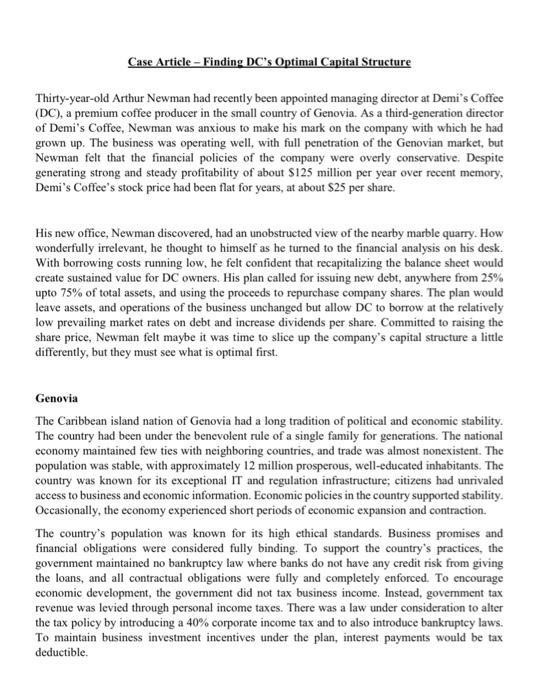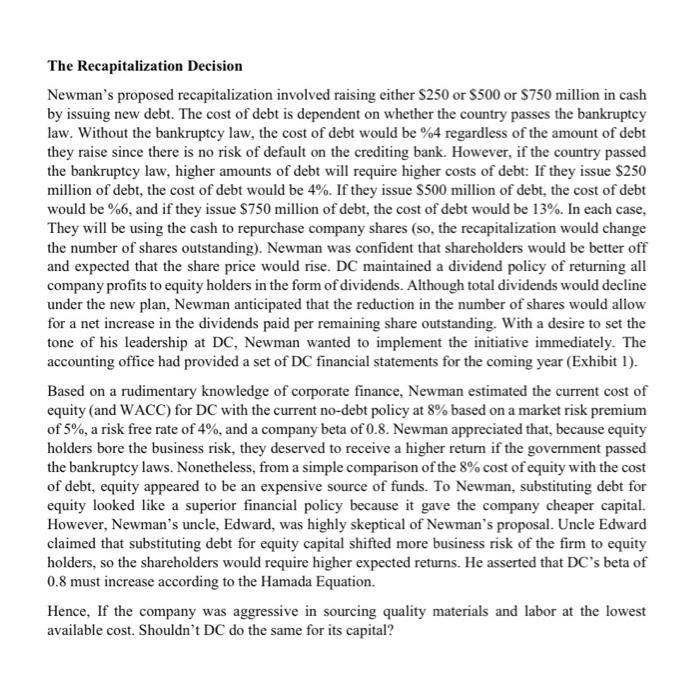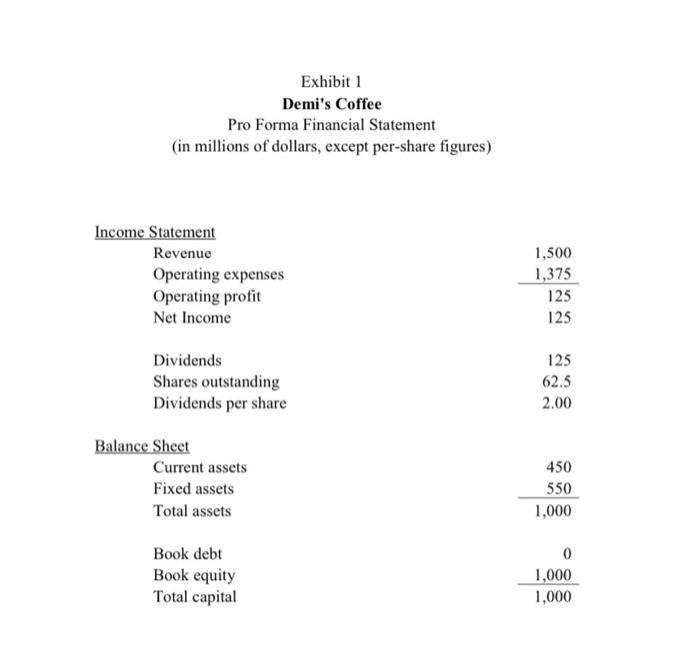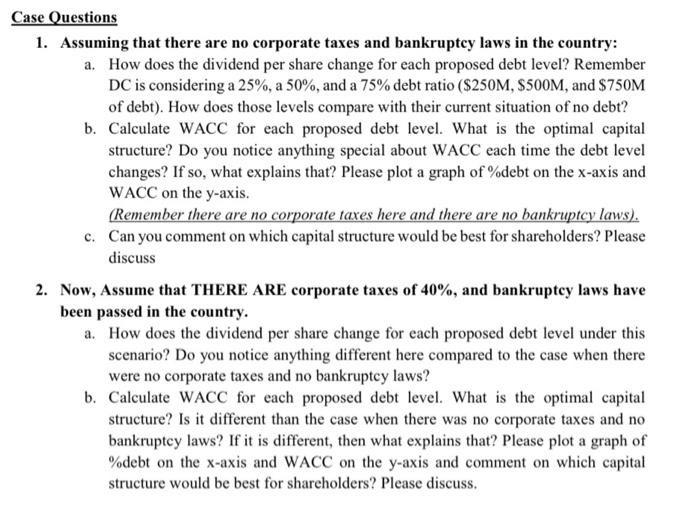Case Article - Finding DC's Optimal Capital Structure Thirty-year-old Arthur Newman had recently been appointed managing director at Demi's Coffee (DC), a premium coffee producer in the small country of Genovia. As a third-generation director of Demi's Coffee, Newman was anxious to make his mark on the company with which he had grown up. The business was operating well, with full penetration of the Genovian market, but Newman felt that the financial policies of the company were overly conservative. Despite generating strong and steady profitability of about $125 million per year over recent memory, Demi's Coffee's stock price had been flat for years, at about $25 per share. His new office, Newman discovered, had an unobstructed view of the nearby marble quarry. How wonderfully irrelevant, he thought to himself as he turned to the financial analysis on his desk. With borrowing costs running low, he felt confident that recapitalizing the balance sheet would create sustained value for DC owners. His plan called for issuing new debt, anywhere from 25% upto 75% of total assets, and using the proceeds to repurchase company shares. The plan would leave assets, and operations of the business unchanged but allow DC to borrow at the relatively low prevailing market rates on debt and increase dividends per share. Committed to raising the share price, Newman felt maybe it was time to slice up the company's capital structure a little differently, but they must see what is optimal first. Genovia The Caribbean island nation of Genovia had a long tradition of political and economic stability. The country had been under the benevolent rule of a single family for generations. The national economy maintained few ties with neighboring countries, and trade was almost nonexistent. The population was stable, with approximately 12 million prosperous, well-educated inhabitants. The country was known for its exceptional IT and regulation infrastructure: citizens had unrivaled access to business and economic information. Economic policies in the country supported stability Occasionally, the economy experienced short periods of economic expansion and contraction. The country's population was known for its high ethical standards. Business promises and financial obligations were considered fully binding. To support the country's practices, the government maintained no bankruptcy law where banks do not have any credit risk from giving the loans, and all contractual obligations were fully and completely enforced To encourage economic development, the government did not tax business income. Instead, goverment tax revenue was levied through personal income taxes. There was a law under consideration to alter the tax policy by introducing a 40% corporate income tax and to also introduce bankruptcy laws. To maintain business investment incentives under the plan, interest payments would be tax deductible The Recapitalization Decision Newman's proposed recapitalization involved raising either $250 or $500 or $750 million in cash by issuing new debt. The cost of debt is dependent on whether the country passes the bankruptcy law. Without the bankruptcy law, the cost of debt would be 4 regardless of the amount of debt they raise since there is no risk of default on the crediting bank. However, if the country passed the bankruptcy law, higher amounts of debt will require higher costs of debt: If they issue $250 million of debt, the cost of debt would be 4%. If they issue $500 million of debt, the cost of debt would be %6, and if they issue $750 million of debt, the cost of debt would be 13%. In each case, They will be using the cash to repurchase company shares (so, the recapitalization would change the number of shares outstanding). Newman was confident that shareholders would be better off and expected that the share price would rise. DC maintained a dividend policy of returning all company profits to equity holders in the form of dividends. Although total dividends would decline under the new plan, Newman anticipated that the reduction in the number of shares would allow for a net increase in the dividends paid per remaining share outstanding. With a desire to set the tone of his leadership at DC, Newman wanted to implement the initiative immediately. The accounting office had provided a set of DC financial statements for the coming year (Exhibit 1). Based on a rudimentary knowledge of corporate finance, Newman estimated the current cost of equity (and WACC) for DC with the current no-debt policy at 8% based on a market risk premium of 5%, a risk free rate of 4%, and a company beta of 0.8. Newman appreciated that, because equity holders bore the business risk, they deserved to receive a higher return if the government passed the bankruptcy laws. Nonetheless, from a simple comparison of the 8% cost of equity with the cost of debt, equity appeared to be an expensive source of funds. To Newman, substituting debt for equity looked like a superior financial policy because it gave the company cheaper capital. However, Newman's uncle, Edward, was highly skeptical of Newman's proposal. Uncle Edward claimed that substituting debt for equity capital shifted more business risk of the firm to equity holders, so the shareholders would require higher expected returns. He asserted that DC's beta of 0.8 must increase according to the Hamada Equation. Hence, If the company was aggressive in sourcing quality materials and labor at the lowest available cost. Shouldn't DC do the same for its capital? Exhibit 1 Demi's Coffee Pro Forma Financial Statement (in millions of dollars, except per-share figures) Income Statement Revenue Operating expenses Operating profit Net Income 1,500 1,375 125 125 125 Dividends Shares outstanding Dividends per share 62.5 2.00 Balance Sheet Current assets Fixed assets Total assets 450 550 1,000 Book debt Book equity Total capital 0 1,000 1,000 Case Questions 1. Assuming that there are no corporate taxes and bankruptcy laws in the country: a. How does the dividend per share change for each proposed debt level? Remember DC is considering a 25%, a 50%, and a 75% debt ratio ($250M, $500M, and $750M of debt). How does those levels compare with their current situation of no debt? b. Calculate WACC for each proposed debt level. What is the optimal capital structure? Do you notice anything special about WACC each time the debt level changes? If so, what explains that? Please plot a graph of debt on the x-axis and WACC on the y-axis. (Remember there are no corporate taxes here and there are no bankruptcy laws). c. Can you comment on which capital structure would be best for shareholders? Please discuss 2. Now, Assume that THERE ARE corporate taxes of 40%, and bankruptcy laws have been passed in the country. a. How does the dividend per share change for each proposed debt level under this scenario? Do you notice anything different here compared to the case when there were no corporate taxes and no bankruptcy laws? b. Calculate WACC for each proposed debt level. What is the optimal capital structure? Is it different than the case when there was no corporate taxes and no bankruptcy laws? If it is different, then what explains that? Please plot a graph of %debt on the x-axis and WACC on the y-axis and comment on which capital structure would be best for shareholders? Please discuss. Case Article - Finding DC's Optimal Capital Structure Thirty-year-old Arthur Newman had recently been appointed managing director at Demi's Coffee (DC), a premium coffee producer in the small country of Genovia. As a third-generation director of Demi's Coffee, Newman was anxious to make his mark on the company with which he had grown up. The business was operating well, with full penetration of the Genovian market, but Newman felt that the financial policies of the company were overly conservative. Despite generating strong and steady profitability of about $125 million per year over recent memory, Demi's Coffee's stock price had been flat for years, at about $25 per share. His new office, Newman discovered, had an unobstructed view of the nearby marble quarry. How wonderfully irrelevant, he thought to himself as he turned to the financial analysis on his desk. With borrowing costs running low, he felt confident that recapitalizing the balance sheet would create sustained value for DC owners. His plan called for issuing new debt, anywhere from 25% upto 75% of total assets, and using the proceeds to repurchase company shares. The plan would leave assets, and operations of the business unchanged but allow DC to borrow at the relatively low prevailing market rates on debt and increase dividends per share. Committed to raising the share price, Newman felt maybe it was time to slice up the company's capital structure a little differently, but they must see what is optimal first. Genovia The Caribbean island nation of Genovia had a long tradition of political and economic stability. The country had been under the benevolent rule of a single family for generations. The national economy maintained few ties with neighboring countries, and trade was almost nonexistent. The population was stable, with approximately 12 million prosperous, well-educated inhabitants. The country was known for its exceptional IT and regulation infrastructure: citizens had unrivaled access to business and economic information. Economic policies in the country supported stability Occasionally, the economy experienced short periods of economic expansion and contraction. The country's population was known for its high ethical standards. Business promises and financial obligations were considered fully binding. To support the country's practices, the government maintained no bankruptcy law where banks do not have any credit risk from giving the loans, and all contractual obligations were fully and completely enforced To encourage economic development, the government did not tax business income. Instead, goverment tax revenue was levied through personal income taxes. There was a law under consideration to alter the tax policy by introducing a 40% corporate income tax and to also introduce bankruptcy laws. To maintain business investment incentives under the plan, interest payments would be tax deductible The Recapitalization Decision Newman's proposed recapitalization involved raising either $250 or $500 or $750 million in cash by issuing new debt. The cost of debt is dependent on whether the country passes the bankruptcy law. Without the bankruptcy law, the cost of debt would be 4 regardless of the amount of debt they raise since there is no risk of default on the crediting bank. However, if the country passed the bankruptcy law, higher amounts of debt will require higher costs of debt: If they issue $250 million of debt, the cost of debt would be 4%. If they issue $500 million of debt, the cost of debt would be %6, and if they issue $750 million of debt, the cost of debt would be 13%. In each case, They will be using the cash to repurchase company shares (so, the recapitalization would change the number of shares outstanding). Newman was confident that shareholders would be better off and expected that the share price would rise. DC maintained a dividend policy of returning all company profits to equity holders in the form of dividends. Although total dividends would decline under the new plan, Newman anticipated that the reduction in the number of shares would allow for a net increase in the dividends paid per remaining share outstanding. With a desire to set the tone of his leadership at DC, Newman wanted to implement the initiative immediately. The accounting office had provided a set of DC financial statements for the coming year (Exhibit 1). Based on a rudimentary knowledge of corporate finance, Newman estimated the current cost of equity (and WACC) for DC with the current no-debt policy at 8% based on a market risk premium of 5%, a risk free rate of 4%, and a company beta of 0.8. Newman appreciated that, because equity holders bore the business risk, they deserved to receive a higher return if the government passed the bankruptcy laws. Nonetheless, from a simple comparison of the 8% cost of equity with the cost of debt, equity appeared to be an expensive source of funds. To Newman, substituting debt for equity looked like a superior financial policy because it gave the company cheaper capital. However, Newman's uncle, Edward, was highly skeptical of Newman's proposal. Uncle Edward claimed that substituting debt for equity capital shifted more business risk of the firm to equity holders, so the shareholders would require higher expected returns. He asserted that DC's beta of 0.8 must increase according to the Hamada Equation. Hence, If the company was aggressive in sourcing quality materials and labor at the lowest available cost. Shouldn't DC do the same for its capital? Exhibit 1 Demi's Coffee Pro Forma Financial Statement (in millions of dollars, except per-share figures) Income Statement Revenue Operating expenses Operating profit Net Income 1,500 1,375 125 125 125 Dividends Shares outstanding Dividends per share 62.5 2.00 Balance Sheet Current assets Fixed assets Total assets 450 550 1,000 Book debt Book equity Total capital 0 1,000 1,000 Case Questions 1. Assuming that there are no corporate taxes and bankruptcy laws in the country: a. How does the dividend per share change for each proposed debt level? Remember DC is considering a 25%, a 50%, and a 75% debt ratio ($250M, $500M, and $750M of debt). How does those levels compare with their current situation of no debt? b. Calculate WACC for each proposed debt level. What is the optimal capital structure? Do you notice anything special about WACC each time the debt level changes? If so, what explains that? Please plot a graph of debt on the x-axis and WACC on the y-axis. (Remember there are no corporate taxes here and there are no bankruptcy laws). c. Can you comment on which capital structure would be best for shareholders? Please discuss 2. Now, Assume that THERE ARE corporate taxes of 40%, and bankruptcy laws have been passed in the country. a. How does the dividend per share change for each proposed debt level under this scenario? Do you notice anything different here compared to the case when there were no corporate taxes and no bankruptcy laws? b. Calculate WACC for each proposed debt level. What is the optimal capital structure? Is it different than the case when there was no corporate taxes and no bankruptcy laws? If it is different, then what explains that? Please plot a graph of %debt on the x-axis and WACC on the y-axis and comment on which capital structure would be best for shareholders? Please discuss










